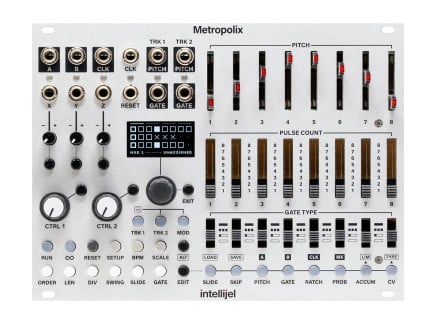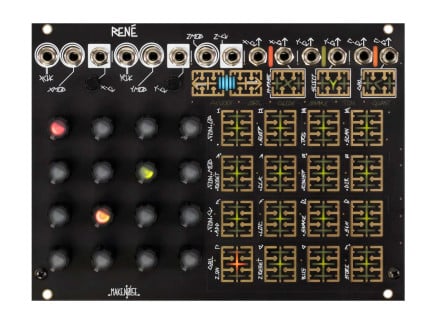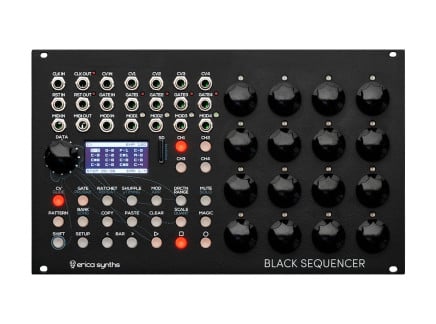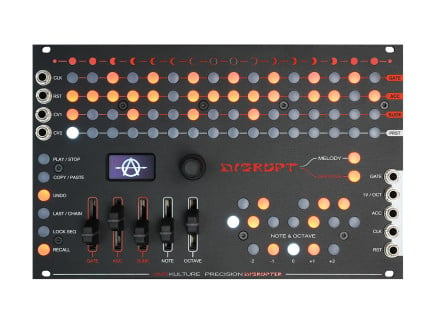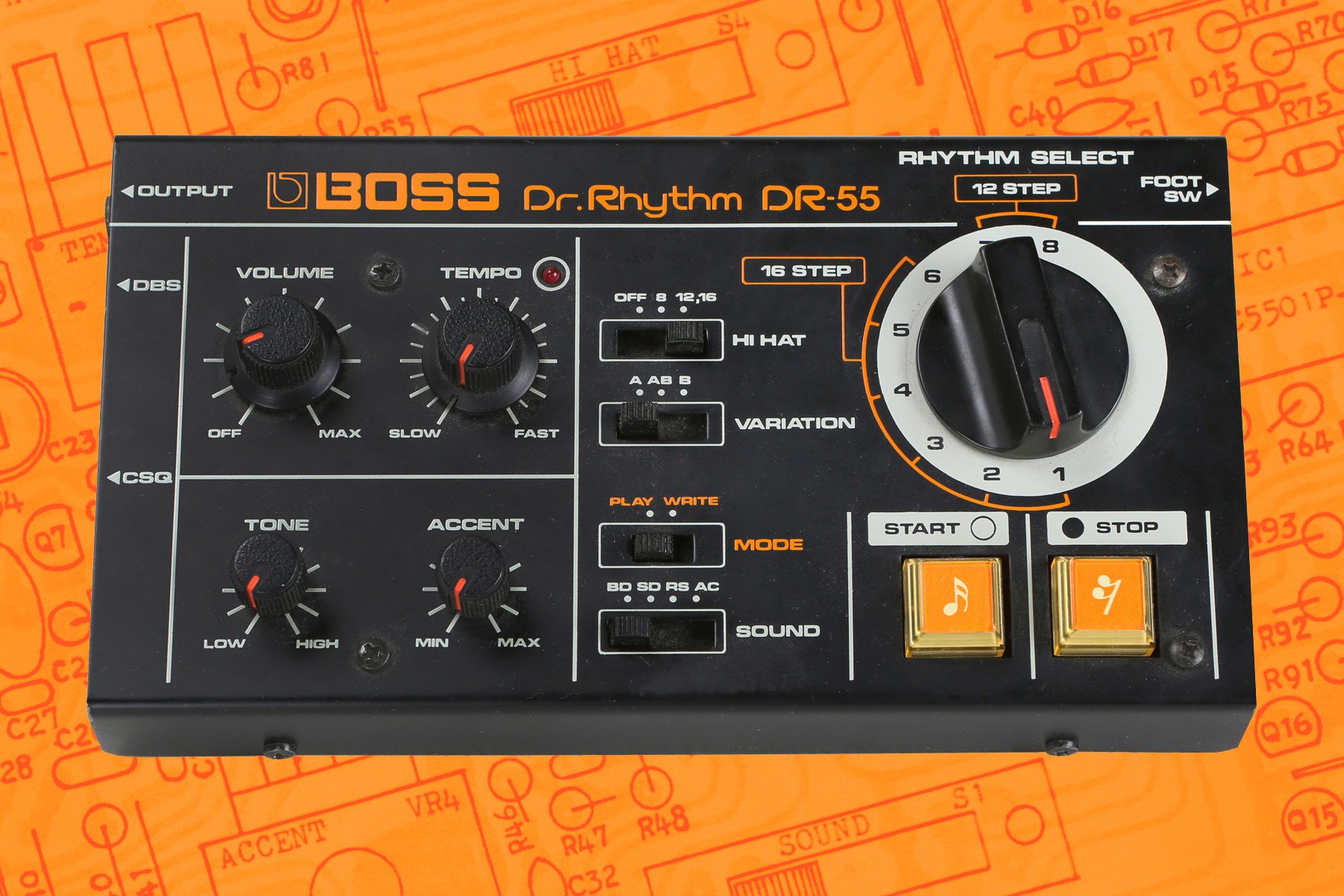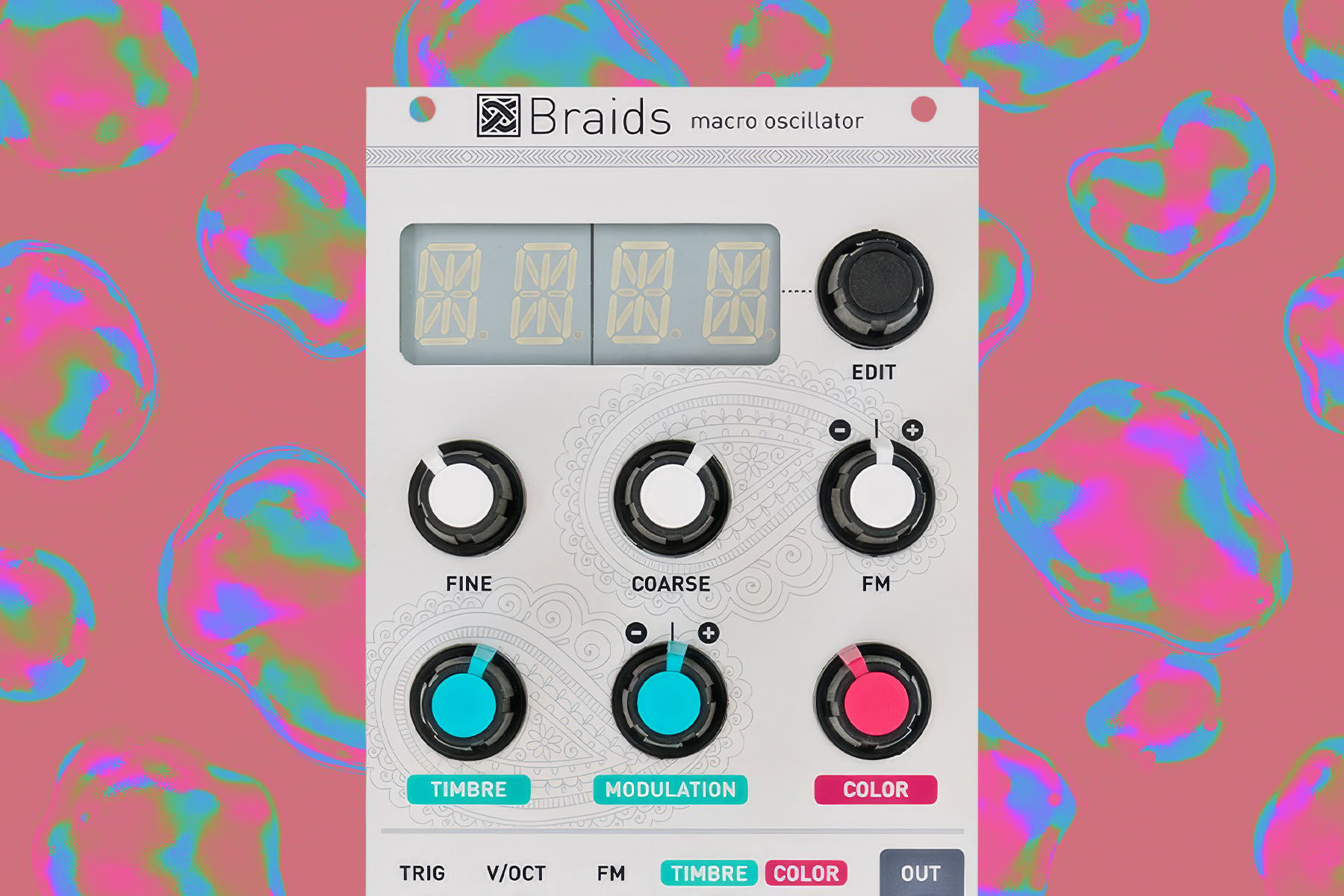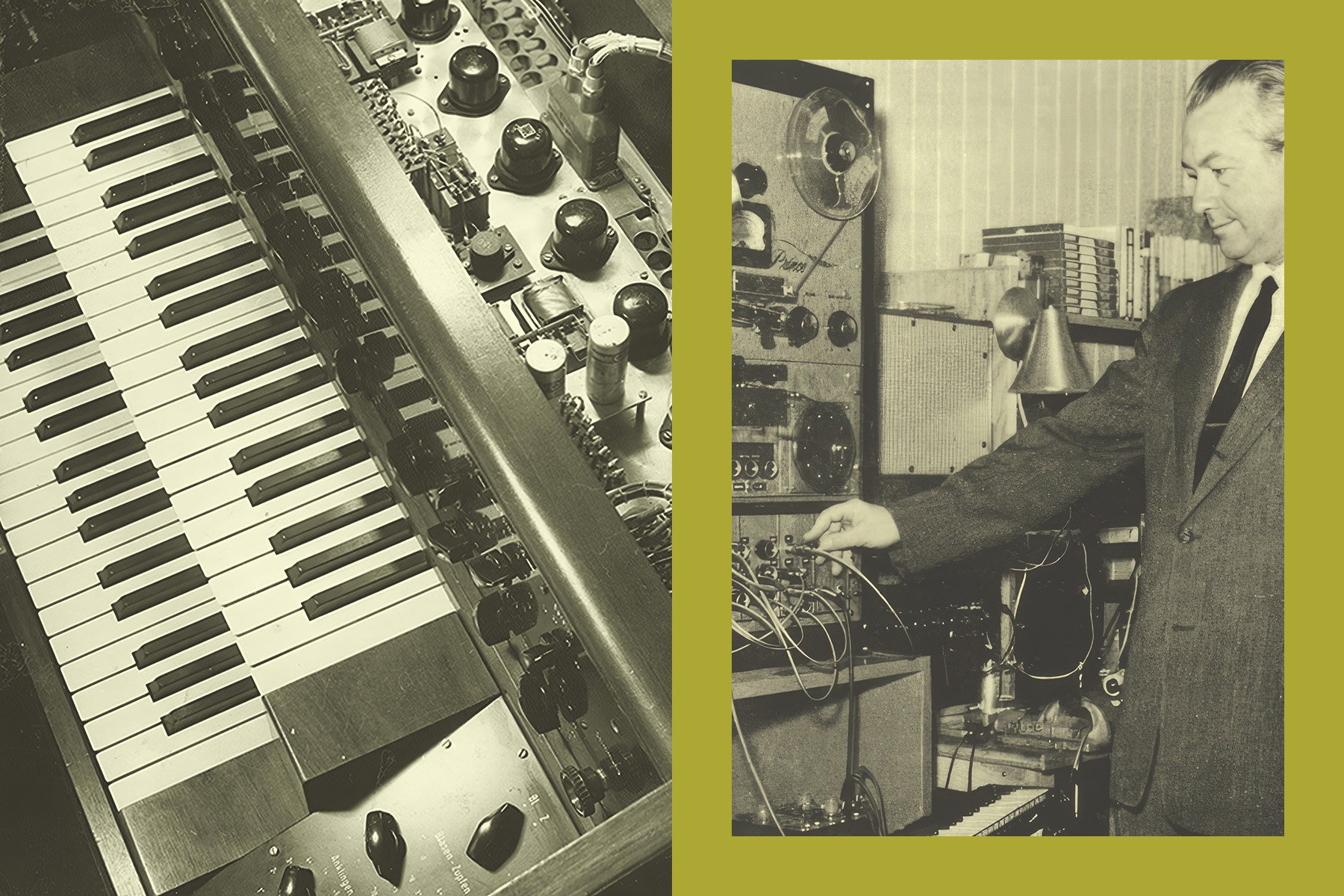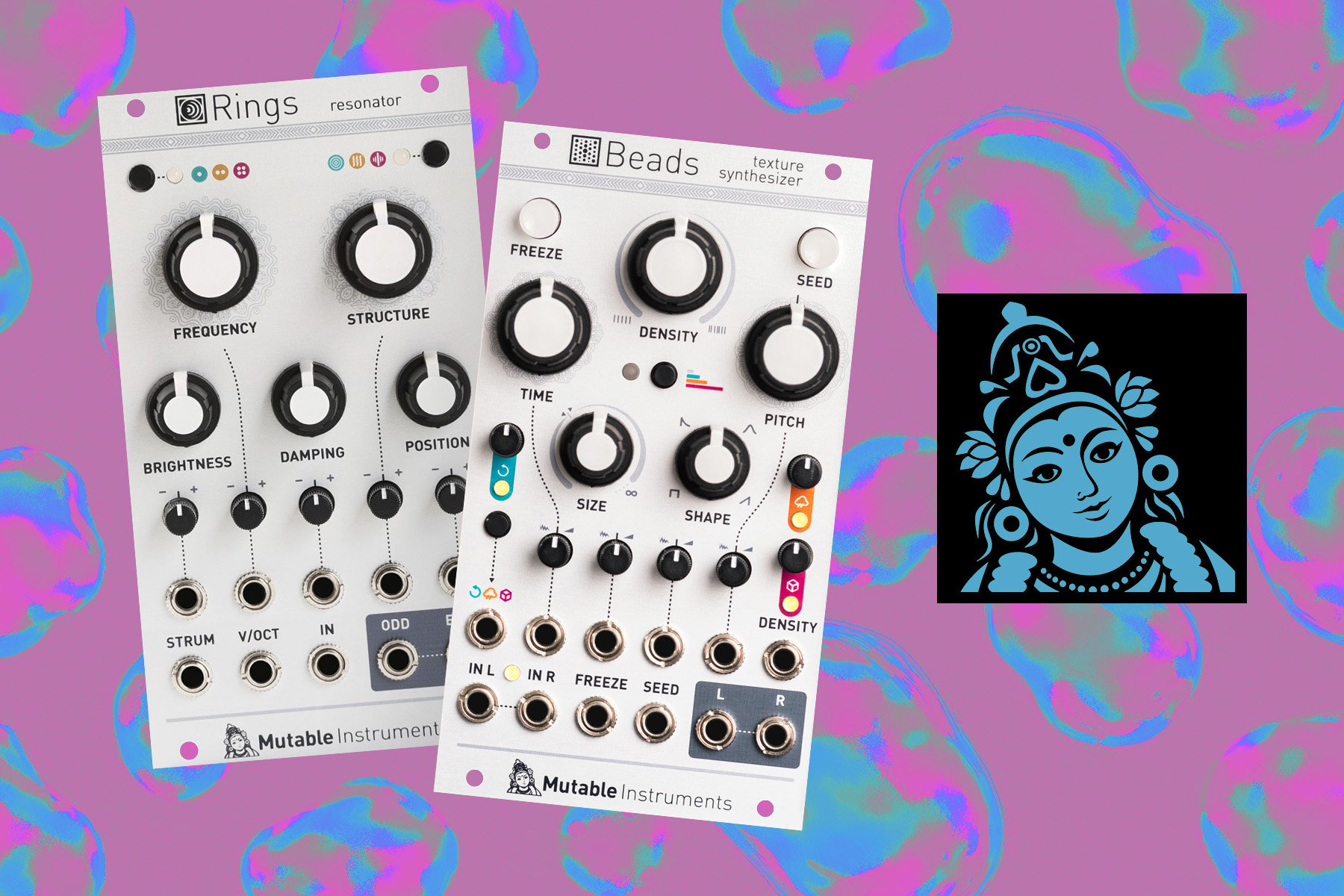In modular synthesis, the sequencer is one of the answers to the question, "How do I play this thing?" Historically, the sequencer was making tunes before we were pulled into the traditional music-making paradigm of the keyboard. However, hardware and modular sequencers have stuck around because they can offer a very different approach and help to bypass the piano-playing exclusivity that synthesizers often require.
A sequencer, in modular terms, generates a number of voltages in a sequence. They form the backbone of our melodies and the spine of our basslines. They can be quantized into musical scales or left to seek out voltage values that work for whatever we want to plug them into. Sequencers can range from simple cycles of steps to complex interwoven lanes of notes and modulations. But in all cases, it will give you a different experience to recording MIDI notes or working with sequencing in a DAW, and that's what makes them fascinating.
Intellijel Metropolix
This is one impressive-looking machine. It's an upgrade to the Metropolis that was based on the M185 sequencer—originally designed for the Roland System 100m by RYK Modular. A current version of that sequencer is available for Eurorack as well, but the Metropolix takes the original M185 concept a bit further.
The basic premise is that you have eight steps to which you can assign a pitch on the top row of sliders. The next row has corresponding Pulse Count switches where you can set up eight pulses for each step. Below that is a row of switches where you can set the Gate Type, which defines the Pulse Count pattern. The result is that rather than having eight notes that cycle around on eight steps, each step can repeat in a selected pattern. It generates interesting and unexpected melody lines and rhythms, with up to sixty-four steps over what is perhaps best described as eight "stages."
From there, the Metropolix adds quite a bit of pizzazz. First of all, there are two tracks. You'd immediately think that these are independent and that you'd have trouble switching from one to another because the setup of the sliders would be different. However, as it happens, the two tracks each use the same pitch and pulse settings, riffing off the same sequence but offering complementary variations. Each track can have its own playback order, length, clock division, swing, slide, and gate lengths. When you start to dig into the menu system and helpful little screen you can find ratchets, probability, pitch inversions, transposition, stage skipping, and a dedicated CV lane.
Alongside your two tracks, there are eight modulation lanes. Each stage on each lane can get a value which can be pumped into any of the internal parameters or routed out to external modules. There are also three CV inputs that can be assigned to suitable controls.
Metropolix is impressive and offers complex possibilities built around a very fun and intuitive sequencer. Oh, and did we mention that it can sequence via MIDI? And that you can get it in a handy standalone enclosure with rear-panel MIDI I/O?
ALM ASQ-1
After the strikingly blue buttons, your eye is immediately drawn to the funny-looking piano made of clacky mechanical QWERTY keyboard keys. You get a full octave with top and bottom C, and you can't help but think that there doesn't seem to be a whole lot more to it.
The ASQ-1 is as simple as it appears, and the best thing about that is how fast you can jam in a sequence and start running your modular. The sequencer is designed around the classic Roland SH-101 style of sequencing, which means you don't record the sequence by performing it; rather, you enter a series of notes, ties, rests, and slides up to 128 steps and then set it running. You can, however, use the keyboard just to play notes if you are not in record or playback mode. During playback, the keyboard can be used to transpose the sequence.
You have two CV/Gate sequencer tracks to play with and a four-channel trigger sequencer, which works slightly differently. Track selection is done with the Mode button and an LED shows you which one you are addressing. In between the Sequencer and Trigger tracks is a Quantizer that will take any incoming CV and lock it to the selected notes on the keyboard. To program the triggers, the eight white notes become eight steps in your pattern. You can tap the keys to turn the step on or off. Using the Hold and Octave keys you can increase the pattern length in banks of 8 to a maximum of 64 steps.
Once you are off and running you can transpose, change lengths, timing, playback direction or enable randomization. The ASQ-1 lacks some of the deeper features of other sequencers but the simplicity makes it very intuitive and playful. The keys feel great, but you also can't help feeling that it's all taking up a lot more space than it really needs to.
Make Noise René 2
The René is a beautifully designed "three-dimensional prism of composition". It's a Cartesian sequencer named after the French philosopher René Descartes. Rather than being a straightforward affair, René attempts to inject some life and surprise into sequencing by moving in three-dimensional cartesian coordinates. Make Noise has a particular way of talking about its products that can, at times, be rather impenetrable. Let's see if we can get to the bottom of it.
René offers three channels of CV/Gate sequencing, called X, Y, and C. You have knobs on the left defining the pitch of the steps and touchpads on the left that show the state of each step's gate. The LEDs in the top of the knobs visualizes the pattern of notes, whereas the LEDs in the touchpads indicate what's happening. So from a basic point of view, the sequence will step its way through the four rows of four knobs, and the knob of the current step will light up. The touchpads that are lit indicate an active step; any unlit ones are skipped. That all seems easy enough, but there are many more modes and things that you can do.
For instance, in gate mode, you can use the touchpads to activate gates for each step without disabling steps that don't have one. Another page lets you add glide, another varies the route being taken by the sequence, and another defines a scale for quantization.
The Cartesian element comes in when you add a second clock to René. The sequencer takes one clock to move horizontally and another to move vertically. This results in the active step snaking its way across the 16 knobs exploring the sequence in a very fluid and organic way—with the current voltage and gate accessible on the C channel's outputs.
There's no doubt that René can be complicated and somewhat baffling at times. However, it's a very creative and imaginative sequencer that will help you explore your modular in ways you haven't thought of before.
Erica Synths Black Sequencer
The Black Sequencer from Erica Synths is a serious four-track machine with deep features and some of the most twistable knobs in the game. They twist and click in the most satisfying way that makes it easy to dial in a sequence with just a few flicks of your fingers. It looks dark, ordered, and complicated, but with the bright screen and a few button presses, it all comes together quite quickly and is terrifically powerful.
Each of the four channels has CV, Gate, and a Modulation output. This is mirrored over MIDI so that everything you do on the sequencer can also be sent to MIDI synths and devices. The way it all works is that the 16 knobs are endless clickable encoders that can be used to change a parameter on any of the bank of 16 steps that are currently selected. You can have up to 64 steps. The sort of per-step parameters you have to play with include pitch or CV, gate length, ratchet, modulation, glide, probability, Arpeggiation, micro-timing, and repeats. As you select each mode, the display shows you the value for each knob. So, twist in a bunch of pitches, dial in a few gate length variations, and draw in a bunch of modulation, and you've got a whole thing going on. It's so quick and relatively intuitive, and the clarity of the display helps keep track of everything.
However, there are depths to this thing that take it to another level. There's a very cool "Magic" button that, if you hold it and press a parameter button it will randomize those values across the 16 steps. But it's not just all over the place; you can scale it back so that the magic is restrained and musical. There's a performance mode where you can use the clicking of an encoder to transpose a sequence or add gate fills or rolls. You can mute and solo channels with a single button press. You can play through the sequencer with a MIDI keyboard that can either be recorded or be used to transpose or take over the sequencer for some live playing mid-set.
The Modulation output gets a lot of special attention with a whole menu system devoted to different modes that you access through the screen. These include stepped or smooth CV, actual notes, so that’s another sequence following the gate pattern of the original, three types of envelope, LFOs and triggers. The trigger option turns the 16 steps into a drum machine, which is amazing.
The Black Sequencer can handle pretty much everything you can think of in both a creative exploration and live performance. You can chain patterns, create songs and make stuff happen on the fly. The percussion side is probably the only weak area with the relatively simple trigger sequencer as part of the modulation engine, but the Erica Synths has a dedicated Drum Sequencer for that kind of thing.
Qu-Bit Bloom
Bloom is a fractal sequencer. It's odd, unique, and surprising—fascinating and baffling. Just when you think you've got the hang of it, Bloom wanders off on its own path in thrillingly creative ways. You have to treat it like a sequencing entity to which you give suggestions rather than an intentional or programmable series of notes.
Behind the scatter of knobs are two channels of up to 32 steps of CV/Gate sequencing and the ability to generate an infinite variation of melody. The variations and mutations come about through fractal algorithms where, rather than selecting random notes, a new melody is generated as a branching-off from the original. It's like a growing tree or expanding moss where change is a deviation rather than a flip to something completely new.
You start off by selecting a Length for the number of steps and setting your core or "Trunk" sequence. On the left of the module is a cascade of eight knobs with a line of LEDs in the middle. These set up our initial sequence and then get employed to do other things via a shift function. On the right, we have our injections of deviation and mutation. The Branches knob adds how many variations will branch off the Trunk sequence, and Path determines how the sequence navigates the Branches. Mutation defines the likelihood of changes to the notes in the Trunk sequence affecting the root of the branch and path parameters. Root changes the root note and varies depending on the scale. Those are your main parameters.
However, you also have other ways of getting involved in the sequence. You can add ratchets and slew and change the scale. With all the deviant knobs turned fully anti-clockwise, you can use it just like any other note sequencer, but where's the fun in that? Bloom will delight and surprise you, especially once you've gotten used to the quirky interface which uses the vertical LEDs to display all sorts of values. But it's the sort of module you can let run and just enjoy where it goes while you explore other tones.
XOR NerdSEQ
The NerdSEQ introduces your modular to the ancient computerized concept of the Tracker Sequencer. A Tracker is a vertically scrolling list of numerical values that somehow describes musical events in a very controllable manner. To the uninitiated, it feels baffling and complex, but to the practised user, it is fast and furiously powerful.
It has six channels, each with a CV, Gate and Modulation output. Unexpectedly, there are four audio tracks for sequencing samples along with integrated oscillators and FM synthesis. In terms of sequencing, you can have up to 176 patterns with 64 steps, which includes 255 sequencer rows of events. NerdSEQ is an adventure playground in fiddly modular form. It has almost endless depths of possibility which include cross-modulation, sequence manipulation, signal routing and support for gamepads, computer keyboards and all sorts of controllers. It's not just about notes; it's a complex algorithm of interconnected happenings.
NerdSEQ works in columns and rows, from top to bottom. Musical notes are usually filled in with their note names, whereas other parameters are given a numeric value. The values are hexadecimal to make it feel extra nerdy, but also because you can describe far more values with two digits than regular base ten. The keys on the front of the sequencer allow for navigation around the tracker grid where you can then enter values. This is not easy with the limited amount of buttons, and so using a PC keyboard could make it less of a struggle.
From there, it's like falling down a rabbit hole. There are sequences within sequences, modulators within modulation, envelopes, automators, samples and FM synthesis. The concepts are not simple, the interface isn't intuitive until you pass through the eureka moment and then, so tracker people tell me, it's a most elegant way to make music.
Notably, the NerdSEQ has a number of optional expanders, as well—assisting with additional CV I/O, video display, gamepad support, and more.
Winter Modular Eloquencer
In terms of elegance, the Winter Modular Eloquencer takes the biscuit. It's beautifully designed, with a heart that likes to meander in organic fields of possibilities while never taking itself too seriously. Its core concept is "Controlled Chance," where dice rolls are used to build variation rather than enforce change.
Eloquencer has a whopping eight tracks of CV/Gate sequencing, but with a rather conservative 16 steps. However, you can chain patterns together to give you a maximum of 256 steps. The matrix of LEDs in the middle displays the active steps across all tracks, and it glimmers and dances as you start to apply the pressure of randomness. You can push random variation into all sorts of places like CV, gate length, ratchet, probability, and the likelihood that something will receive some variation. The general idea is that you create your sequences and then set the conditions around how much they are going to be let loose into chance-driven variation.
The visualization is excellent. It gives you a sense of where you are and what's going on at any given moment. The OLED screen next to the matrix gives you further details on the step and the functions you are exploring. The two rows of eight buttons at the bottom can be used to add gates to the 16 steps of a track. You can then hold a button to set a CV value for that step or use the same buttons as a rough piano keyboard and play in some notes live. Along with CV and Gate you also have buttons for Gate Length and Ratchet, and all the time you're setting the probability that these events will happen. It's very quick and obvious, and in no time, you can program in some percussive patterns or lines of melody while the sequencer is looping.
You can quickly generate patterns by duplicating your original one on the fly. It allows you to make a copy, and then add some variation. From there, you can duplicate again to develop it further, leaving patterns behind that you can return to. So, just through playing with Eloquencer you can end up with dozens of possibilities to work into your tracks.
Eloquencer is a fun, visual and engaging machine that you can trust to take you to creative places.
Anti-Kulture Precision Disrupter
The Precision Disrupter is a dazzling array of illuminated buttons that invite you into a single track of 16-step generative sequencing. The matrix of events at the top is coupled to a bunch of sliders that define the events as gates, accents, sliders or notes and octaves. There's a little octave-sized keyboard built in for your melodies and a screen to tell you what's happening. But the power of the Precision Disrupter is in the visualization of those 16 steps and the ability to disrupt both melody and rhythm at the touch of a button.
What's different here is how the patterns are generated. Instead of turning on or off individual steps, you grab the Gate slider and start to bring it up. As you do, the 16 steps of the Gate row start to populate. The further you push it, the more complex the rhythm until every button is lit. It's instant rhythmic bliss! Adding notes is also a bit different. For this, we use the little keyboard. Holding a button on the keyboard turns it into the root note for your sequence, and you can do the same for the octave buttons beneath it. Then, you turn whatever notes and octaves you would like to hear in your sequence on. It feels a lot like using a Quantizer. When you're ready, you can start bringing up the Note and Octave sliders to introduce your chosen notes into the pattern.
That is what the core of the Precision Disrupter is all about. You can do exactly the same to bring in the row of Accents or the Slides. You are inviting patterns and melodies into your modular and evolving the live, rather than dictating or programming them in. It's almost alarmingly easy to get fantastic results.
However, once you have something you like you can mess it about with the Disrupt button. The Melody and Groove buttons apply instantaneous changes to your patterns while respecting the existing parameters, keeping it all hanging together beautifully. You can also manually turn on or off any gate, accent, or slide and adjust the pitch as desired. The bottom row is a handy storage facility for up to 16 patterns, so if you prefer to do your disrupting before the gig, you can have a host of patterns ready to go.
Despite only offering one track of sequencing, the Precision Disrupter offers a fast and detailed way of getting directly into the groove of pattern-based sequencing.
Vermona Melodicer
Melodies on a dice roll are what Melodicer is all about. The basic idea is that you have a slider for every note in the scale, and as you push them up that note is given more importance and so is more likely to appear in the sequence. You can define the range and octave of the sequence, but after that you give it some notes and let Melodicer take care of everything else.
You do have a bit of control over the gates and rhythm structure through the knobs at the top. You can set a starting point for the note length and then move the Variation knob to push the notes into either being longer or shorter. Legato will drop gates, making the rhythm simpler to the point of silence, and Rest suggests that notes should tie to each other from time to time. Always the knobs are adding suggestions and pushing their own agendas rather than forcing the Stochastic algorithms to bend to their will.
As you push and fiddle with the note sliders, sequences begin to emerge. At no point do you feel like you are writing a sequence; it's more that you are applying influence and favouring certain notes and possibilities. Melodicer ultimately makes all the decisions. There are two dice buttons, one for melody, one for rhythm, and you can use them to make Melodicer change its mind and conjure up a new variation. You can also bypass the dice and drop Melodicer into an infinite space of constant evolution.
At this point, you can sit back and enjoy the melodies as they unfurl. Sometimes, the loops can get a bit samey, which is why the Dice buttons are so useful. You also have a way of rotating the sequence through the circle of LEDs at the top right. It pushes the sense of rhythm in and out of whack, generating more interest and variation.
Melodicer will keep you on your toes and make you feel very clever while never being sure if you're doing anything at all.
4MS Catalyst Sequencer
The Catalyst Sequencer sometimes feels like it's a puzzle you're trying to solve. Through the often cryptic use of colour, modes, and button combos, you will find 8 banks of 8 steps for 8 channels of sequencing. You can chain them up to a maximum of 64 steps. Each channel has a single output, which can be CV, quantized CV or Gates. So, if you wanted regular CV/Gate sequencing, you'd have to set four channels up as CV and four as Gate and then remember which two channels are working together to run the one sequence. On the one hand, it's very versatile, but on the other, you can't help but feel the slight disconnect between your rhythm and melody.
Pulling a sequence together is relatively easy. The eight buttons select between the eight banks or "pages" of 8 steps. While holding the Chan button you can twist the first knob, and it kaleidoscopes through 14 possible musical scales. Then release the button and twist each knob to set a pitch for each step, and you're off. Using the Shift button lets you access other features on the knobs like start point, direction, length, range, tempo, transposition, randomization of the pitch, and phase, or order of the notes. You can also add Glide and Probability to each step by holding another button.
For gates, you can use the same scale selection knob to select Gate Mode, and now each knob, lit in green, is a step on/off control. You can increase the gate length, add ratchets, probability and swing. In CV mode the probability adds a possible variation to the pitch; in Gate mode, it's the probability of whether it fires or not.
The big "Phase Scrub" crossfader in the middle of the module is used to push through the sequencers steps. You can manually move through steps in either direction, which can be interesting although it's actually more interesting to use the Phase CV input. Patch in an LFO, Sample & Hold or other sequence, and you can resequence the sequence by selecting different steps. The crossfader comes into play much more with the alternative Controller firmware that you can upload to the Catalyst Sequencer. But that's a story for another day.
Endorphin.es Ground Control
Ground Control is designed to be the central hub of your live performance. It can run three melodic tracks of CV/Gate and a single track of percussion driving eight trigger outputs or piped over MIDI to other synths. That sounds like a case worth of synth voices and a case filled with percussion modules and you have everything you need for a modular gig.
Each track can be up to 128 steps (with latest firmware) and generally speaking, to make a melodic sequence, you play it in using the buttons on the front. The buttons are arranged like a two-octave keyboard so tapping out your melodies is a breeze. You can apply a bit of glide to notes by playing legato, which means playing the next one before releasing the last one. Alternatively, there's an SH-101 mode where you can enter a stream of notes in step-time and add rests and ties to program your sequence. All the steps and notes in the sequence can be edited by hand, where you can also add glide and ratchets.
There's also another way via the nifty arpeggiator mode, which is not something you commonly see on a modular sequencer. Using the keyboard, you can hold down notes, and the arpeggiator will play those notes for you in a direction and mode of your choosing and, if you want, record them into the sequencer. A "Super Latch" function lets you add and remove notes from the arpeggiation by tapping them rather than holding them all at once. The versatility of Ground Control is quite amazing.
The drum track has a few individual features. You can use the top row of the keyboard (the "black" notes) to play the eight triggers and record in real time, like with the other tracks. The SH-101 modes also works in that you could program in a bunch of triggers in a stream. However, it also has a X0X mode that follows the Roland TR-808 style of drum programming, where you have a row of steps and you turn them on or off. This is one place where the Ground Control misfires slightly—it uses the bottom row of buttons for the 16 steps, except there are only 14 of them (for the two-octave keyboard). So to make up the 16 steps it includes the F# and Eb keys, which in practice feels a bit odd. I've also just noticed that the keyboard starts on an F, which is also a bit strange, but I guess it's what they had to do to make the functions of the buttons work. It does work very well, but takes some getting used to.
All the parameters can be modulated via the CV inputs, including sequence direction and rotation. There's also a sort of reversed probability factor that defines the possibility of missing notes. It has an uncanny way of turning any sequence into an ambient exploration. In a recent firmware update, Endorphin.es has introduced a random pattern generator and pattern variation engine. It can use different algorithms to generate rhythms on the fly.
Ground Control is undoubtedly a superb sequencer for running your modular.


